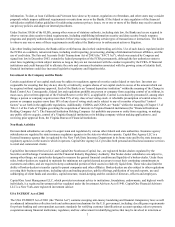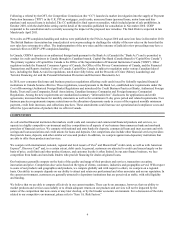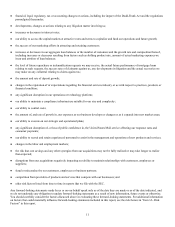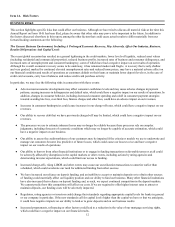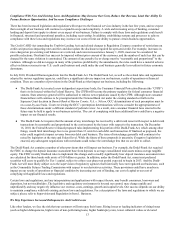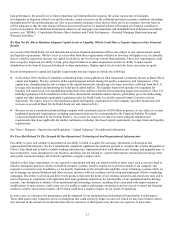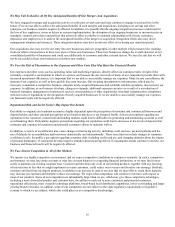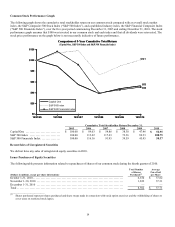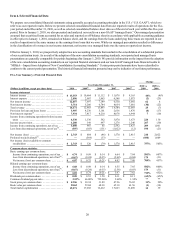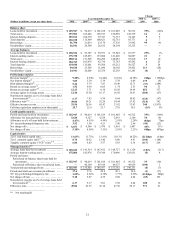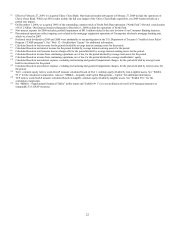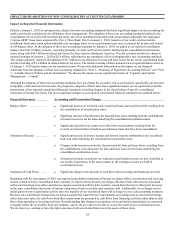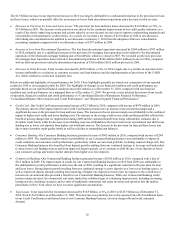Capital One 2010 Annual Report Download - page 36
Download and view the complete annual report
Please find page 36 of the 2010 Capital One annual report below. You can navigate through the pages in the report by either clicking on the pages listed below, or by using the keyword search tool below to find specific information within the annual report.16
We May Fail To Realize All Of The Anticipated Benefits Of Our Mergers And Acquisitions
We have engaged in merger and acquisition activity over the past several years and may continue to engage in such activity in the
future. If we are not able to achieve the anticipated benefits of such mergers and acquisitions, including cost savings and other
synergies, our business could be negatively affected. In addition, it is possible that the ongoing integration processes could result in
the loss of key employees, errors or delays in systems implementation, the disruption of our ongoing businesses or inconsistencies in
standards, controls, procedures and policies that adversely affect our ability to maintain relationships with clients, customers,
depositors and employees or to achieve the anticipated benefits of the merger or acquisition. Integration efforts also may divert
management attention and resources. These integration matters may have an adverse effect on us during any transition period.
Our acquisitions also may involve our entry into new businesses and new geographic or other markets which present risks resulting
from our relative inexperience in these new areas or these new businesses. These new businesses change the overall character of our
consolidated portfolio of businesses and could react differently to economic and other external factors. We face the risk that we will
not be successful in these new businesses or in these new markets.
We Face the Risk of Fluctuations in Our Expenses and Other Costs That May Hurt Our Financial Results
Our expenses and other costs, such as operating, labor and marketing expenses, directly affect our earnings results. In light of the
extremely competitive environment in which we operate, and because the size and scale of many of our competitors provide them with
increased operational efficiencies, it is important that we are able to successfully manage our expenses. Many factors can influence the
amount of our expenses, as well as how quickly they may increase. Our on-going investments in infrastructure, which may be
necessary to maintain a competitive business, integrate newly-acquired businesses and establish scalable operations, may increase our
expenses. In addition, as our business develops, changes or expands, additional expenses can arise as a result of a reevaluation of
business strategies, management of outsourced services, asset purchases or other acquisitions, structural reorganization, compliance
with new laws or regulations or the integration of newly acquired businesses. If we are unable to successfully manage our expenses,
our financial results will be negatively affected.
Reputational Risk and Social Factors May Impact Our Results
Our ability to originate and maintain accounts is highly dependent upon the perceptions of consumer and commercial borrowers and
deposit holders and other external perceptions of our business practices or our financial health. Adverse perceptions regarding our
reputation in the consumer, commercial and funding markets could lead to difficulties in generating and maintaining accounts as well
as in financing them. Particularly, negative perceptions regarding our reputation could lead to decreases in the levels of deposits that
consumer and commercial customers and potential customers choose to maintain with us.
In addition, a variety of social factors may cause changes in borrowing activity, including credit card use, payment patterns and the
rate of defaults by accountholders and borrowers domestically and internationally. These social factors include changes in consumer
confidence levels, the public’s perception regarding consumer debt, including credit card use, and changing attitudes about the stigma
of personal bankruptcy. If consumers develop negative attitudes about incurring debt or if consumption trends continue to decline, our
business and financial results will be negatively affected.
We Face Intense Competition in All of Our Markets
We operate in a highly competitive environment, and we expect competitive conditions to continue to intensify. In such a competitive
environment, we may lose entire accounts or may lose account balances to competing financial institutions, or we may find it more
costly to maintain our existing customer base. Customer attrition from any or all of our lending products, together with any lowering
of interest rates or fees that we might implement to retain customers, could reduce our revenues and therefore our earnings. Similarly,
customer attrition from our deposit products, in addition to an increase in rates or services that we may offer to retain those deposits,
may increase our expenses and therefore reduce our earnings. We expect that competition will continue to increase with respect to
most of our products. Some of our competitors are substantially larger than we are, which may give those competitors advantages,
including a more diversified product and customer base, the ability to reach out to more customers and potential customers,
operational efficiencies, more versatile technology platforms, broad-based local distribution capabilities, lower-cost funding and larger
existing branch networks. In addition, some of our competitors are not subject to the same regulatory requirements or legislative
scrutiny to which we are subject, which also could place us at a competitive disadvantage.



